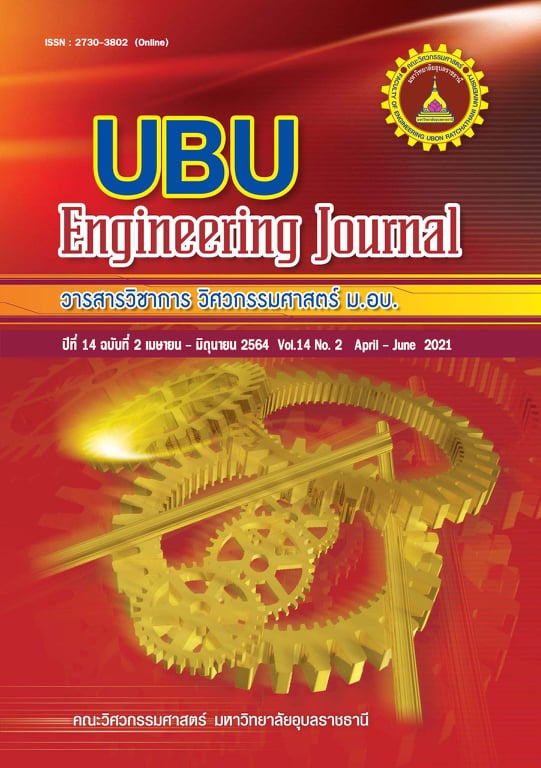Walking model for gait training for children with cerebral palsy
Main Article Content
Abstract
The purpose of this research is to study the walking model of gait training for Children with Cerebral Palsy.
The proportions of the walking mechanism are considered according to the ergonomic principles of the physiology of Thai children in the age of 3 – 12 years old. The principle of movement of the four – bar linkages to finding the step length is also considered. The walking model, which has been used to build a prototype of stationary gait training, is a device that helps Physiotherapists to perform physical therapy for Children with Cerebral Palsy. The result shows that the maximum step length of this mechanism is 133.129 millimeters. In addition, it is found that the distance used for gait training also depends upon the speed chosen for training.
Article Details
References
[2] พรรณี ปิงสุวรรณ. กายภาพบำบัดในเด็กสมองพิการ. พิมพ์ครั้งที่ 2, โรงพิมพ์มหาวิทยาลัยขอนแก่น, ขอนแก่น; 2559.
[3] ธวัชชัย อุ่นใจจม, กุลทรัพย์ ผ่องศรีสุข, จิระวัฒน์ ขันติธรางกูร. การพัฒนาเครื่องช่วยฝึกนั่ง-ยืน สำหรับผู้ป่วยเด็กสมองพิการ. วารสารวิชาการรับใช้สังคม มทร.ล้านนา. 2562; 3(1); 55-61.
[4] ปรีชา บานกลีบ, จตุรวิทย์ กฐินใหม่, ประกาศิต ตันติอลงการ. จักรยานกายภาพบำบัดแขนและขาสำหรับเด็กพิการทางสมอง. ใน การประชุมวิชาการครุศาสตร์อุตสาหกรรมระดับชาติ ครั้งที่ 8, 26 พฤศจิกายน 2558; คณะครุศาสตร์อุตสาหกรรม มหาวิทยาลัยเทคโนโลยีพระจอมเกล้าพระนครเหนือ; 2558. หน้า 13 – 18.
[5] Tarapong K,Radom P. Synchronization Control Scheme for Gait Training Robot and Treadmill. In: 2014 International Computer Science and Engineering Conference (ICSEC); 2014 July 30 – August 1. Pullman Khon Kaen Raja Orchid Hotel, Khon Kaen, Thailand; 2014.P.481-485.
[6] Made for Movement. Innowalk. Available from: http://www.madeformovement.com/innowalk/ [Accessed 25th April 2020].
[7] วิฑูรย์ สิมะโชคดี และกฤษฎา ชัยกุล. เออร์กอนอมิกส์. สำนักพิมพ์สมาคมส่งเสริมเทคโนโลยี (ไทย-ญี่ปุ่น), กรุงเทพฯ; 2548.
[8] กรมอนามัย. เกณฑ์อ้างอิงน้ำหนัก ส่วนสูง และเครื่องชี้วัดโภชนาการของประชาชนไทยอายุ 1 วัน –19 ปี. กระทรวงสาธารณสุข; 2542.
[9] ศรีกาญจนา จตุพัฒน์วโรดม. ขนาดตัวมาตรฐานเด็กไทย: การพัฒนาหุ่นขนาดตัวมาตรฐานเด็กไทย. มหาวิทยาลัยเทคโนโลยีราชมงคลธัญบุรี, ปทุมธานี; 2558.
[10] กลางเดือน โพชนา และองุ่น สังขพงศ์. การประมาณค่าขนาดสัดส่วนร่างกายเพื่อการออกแบบโต๊ะเก้าอี้นักเรียนระดับประถมศึกษา. ปริญญานิพนธ์วิศวกรรมศาสตรบัณฑิต สาขาวิศวกรรมอุตสาหการ คณะวิศวกรรมศาสตร์ มหาวิทยาลัยสงขลานครินทร์; 2550.
[11] Christopher LV, Brian LD, Jeremy COC. Dynamics of Human Gait. Second Edition. South Africa: Kiboho Publishers; 1999.
[12] Kenneth JW, Gary L. Kinzel. Kinematics, Dynamics, and Design of Machinery. Second Edition. NJ, USA: John Wiley & Son, Inc.; 2004.
[13] Hamilton HM, Charles FR. Mechanisms and Dynamics of Machinery. Fourth Edition. NJ, USA: John Wiley & Son, Inc.; 1987.
[14] Scilab 6.0.2. ESI Group. French. 2019.
[15] Michael B. Programming in Scilab. September 2011.
[16] Robert LN. Design of Machinery. Third Edition. New York, USA. McGraw-Hill. 2004.
[17]MeriamJL,KraigeL. G. Engineering Mechanics: Dynamics. Seventh Edition. NJ, USA: John Wiley & Son, Inc.; 2012.

